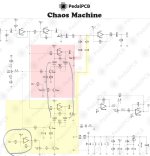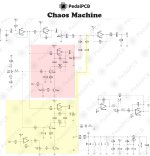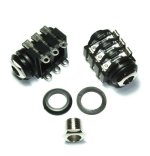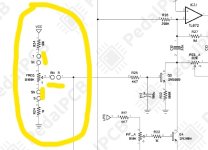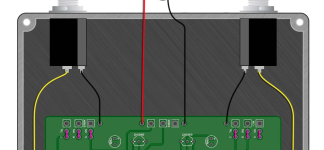This should have been a buggy, frustrating build but looking back it went off without a hitch. It seemed like a great noise rock pedal (based, I'm assuming on the discontinued EQD Interstellar Orbiter) that I bought on a whim. I put it together very straightforward but if I had it to do over again I would have studied @Chuck D. Bones excellent threads on LFOs and would have identified areas of the circuit to tweak and then socketed those locations. As this was my first attempt at a noise pedal I just did it straight from the instructions.
The only thing I can think of to criticize about either my build or this circuit is probably the "Direct" dial. That is supposed to mix the dry guitar signal in with the filter circuit and to my ears it is doing something but it never gets completely dry. Maybe I did something wrong. Does any other Chaos Machine owners know if that pot will let you get to a 100 percent dry signal?
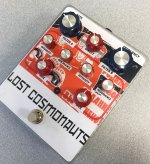
If anyone has recommendations as to what components should be socketed, that would be much appreciated. It seems like you could easily install a couple of trim pots in place of resistors but I'd be worries about doing that myself since the LFO circuit is, by design, a Cat's Cradle and small changes here have downstream effects that may cause the pedal to quit working. I just wanted to get to the point of playing this so didn't mess around. But I would love to have a deeper understanding of the circuit.
The art was basically a white vinyl sticker as a background and then a clear vinyl sticker with the colors. "Lost Cosmonauts" was a free font that I found online. I can't remember what connection it had to Russian propaganda posters, but I think it was a font commonly found on them. The rest of the art is just a Russian Propaganda poster of their space program with a few faces blocked out to give the pop art effect I was looking for.
Anyway, this was actually a smooth build. I'd read many troubleshooting threats about ticking problems, but for whatever reason I never encountered them. So, I guess I got lucky.

The only thing I can think of to criticize about either my build or this circuit is probably the "Direct" dial. That is supposed to mix the dry guitar signal in with the filter circuit and to my ears it is doing something but it never gets completely dry. Maybe I did something wrong. Does any other Chaos Machine owners know if that pot will let you get to a 100 percent dry signal?

If anyone has recommendations as to what components should be socketed, that would be much appreciated. It seems like you could easily install a couple of trim pots in place of resistors but I'd be worries about doing that myself since the LFO circuit is, by design, a Cat's Cradle and small changes here have downstream effects that may cause the pedal to quit working. I just wanted to get to the point of playing this so didn't mess around. But I would love to have a deeper understanding of the circuit.
The art was basically a white vinyl sticker as a background and then a clear vinyl sticker with the colors. "Lost Cosmonauts" was a free font that I found online. I can't remember what connection it had to Russian propaganda posters, but I think it was a font commonly found on them. The rest of the art is just a Russian Propaganda poster of their space program with a few faces blocked out to give the pop art effect I was looking for.
Anyway, this was actually a smooth build. I'd read many troubleshooting threats about ticking problems, but for whatever reason I never encountered them. So, I guess I got lucky.

Attachments
Last edited:




